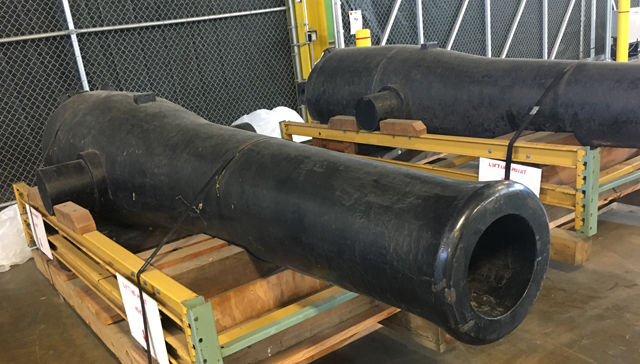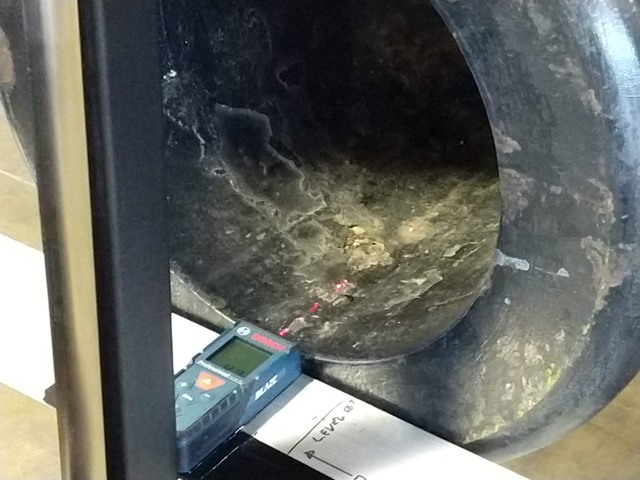Today’s question seems like a simple one – how long is a Dahlgren Shell Gun? As I mentioned previously, I am designing a set of drilling equipment to clean inside the XI-Inch Dahlgrens recovered from USS Monitor, and as part of that I need to establish parameters for actually using the drilling equipment. Well, one very important parameter to know is how far in can you drill? There are two ways to answer that question: you either need to know exactly how deep the bore is before you begin, or you keep pushing the drill into the gun until it hits metal. Given that the latter option cuts a shiny new groove into the back of the bore, I like to aim for the former.
Fortunately, guns from the 19th century often have government ordnance records or patent drawings which give more or less complete dimensions, and Dahlgren shell guns in particular have both patent drawings and multiple Board of Ordnance drawings which survive. Unfortunately, they don’t all match. The patent drawing gives a standard ratio for all Dahlgren shell guns that the bore should be 12 calibers in length, meaning an XI-Inch gun should have a bore 132” in length. The Board of Ordnance drawings give a bore length of 131.2” for an XI-Inch Dahlgren, or approximately 11.93 calibers. In addition, we have both Board of Ordnance pattern drawings and inspection drawings, and while the bore lengths are the same between them, the powder chambers have different measurements.


If we cleaned the bore based on the patent measurements and the Board of Ordnance measurements were really correct, we would cut a ¾” deep groove into the back. If we worked to the Board of Ordnance measurements and the patent dimensions were correct, we wouldn’t remove enough concretion to be effective. And in both cases, working to the wrong drawing means we cut several shiny new grooves into the metal of the powder chamber.
How, then, do we know which set of drawings to use? The Board of Ordnance pattern drawing is more likely to be correct, but do we really want to gamble on that? If only we could measure the guns underneath the concretion, then we would know…
We may not be able to measure the guns from Monitor before cleaning them, but there are other XI-Inch Dahlgren Shell Guns in existence in their original condition. There are even at least two cast by the same foundry – West Point – as Monitor’s guns, one from USS Savannah and one from USS Kearsarge. The gun from Kearsarge, fortunately, is in the collections of Naval History and Heritage Command (NHHC), who were kind enough to let us measure it!

First, we needed to figure out how to measure the interior of a Dahlgren with a high degree of accuracy. Three dimensional laser scanning would be an ideal method, but cost and access to the location made this option difficult. The usual method for accurate three-dimensional rendering used on Monitor objects – photogrammetry – could not be accurately carried out in such a confined space. But really, we only need a profile, not a full three dimensional model. So we decided to use a simple laser tape measure (the same sort you can buy at any hardware store), and mounted it onto a copystand with adjustable feet. Using a digital level and a cardboard template we could adjust the laser into the same plane as the axis of the gun bore, and then we could simply take a series of point measurements in a line from the bottom of the bore to the top. We tested this contraption on a IX-Inch Dahlgren in the Mariners’ Museum collections, and it worked!

Once we knew the method worked on a IX-Inch gun, we could adapt it to use on the XI-Inch gun from Kearsarge. An 11 inch template was drawn to help align the measuring device, and we packed everything up for a trip to NHHC’s Collections and Conservation facility in Richmond, VA.



It’s not a perfect method – using normal hardware-store equipment introduces some error – but it works! From the measurements we took on the USS Kearsarge Dahlgren, we were able to match the Board of Ordnance pattern drawing from 1851, so now we know that West Point guns (like Kearsarge and Monitor’s) are built to that pattern. Now we can use both the Board of Ordnance pattern and our direct measurements from the Kearsarge gun in the future when we clean the bores of Monitor’s guns, and determine exactly how far in each drill should go.
Huge thanks go to our friends over at Naval History and Heritage Command for helping us out, and you can read their article on the collaboration here!
Now that we have accurate measurements to use inside Monitor’s guns there should be no guesswork, no fuss (well, maybe a little math…), and no cutting shiny new grooves in the back of the bore!
Sources:
Dahlgren, J.A. (1851, March) “XI-Inch Shell-Gun.” RG74: Black Number Ordnance Drawings, Drawing #3169. National Archives and Records Administration, Cartographic Section. College Park, Maryland.
Dahlgren, J.A. (1861) “Cast Iron Ordnance.” US Patent No. 32,983. August 6, 1861. https://patents.google.com/patent/US32983A/en?q=~patent%2fUS32983A
Olmstead, E., W.E. Stark, S.C. Tucker (1997) The Big Guns: Civil War Siege, Seacoast, and Naval Cannon. Museum Restoration Servicer, Bloomfield, Ontario, Canada.
US Navy (1866) Ordnance Instructions for the United States Navy. 4th edition. Washington DC, USA, The Navy Department. https://archive.org/details/ordnanceinst00navyrich/page/n11